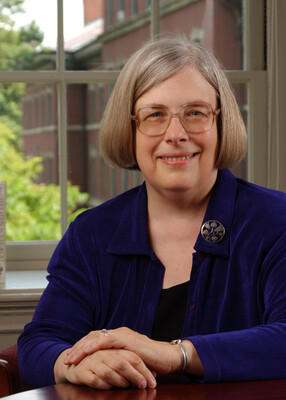Right On
Scholars point to continuing strength of conservatism in the aftermath of the 2020 election.

Research at Risk: Since World War II, universities have worked with the federal government to create an innovation ecosystem that has yielded life-changing progress. Now much of that work may be halted as funding is withdrawn. Find out more about the threats to medical, engineering, and scientific research, as well as how Harvard is fighting to preserve this work—and the University's core values.
Over 70 million Americans cast a ballot for President Donald Trump on November 3. Despite losing the election, Trump collected more votes than any sitting president in US history—and more than he had collected for his surprising win in 2016. Democrats and many “Never Trump” Republicans were stunned by the support for Trump in a year when a global pandemic claimed the lives of nearly a quarter of a million Americans and left millions unemployed and facing economic hardship.
Theda Skocpol was not.
“In Cambridge, Massachusetts, we're all thinking, ‘You know, what do the scientists say about the virus and how we should respond?’” she says. “That's not how they think about it in Trump country. They want somebody who champions the economy and getting back to normal. That's what Trump did, and his voters came out in droves.”
As the Victor S. Thomas Professor of Government and Sociology, Skocpol has spent much of the last decade studying the American right. The former dean of the Graduate School of Arts and Sciences (GSAS), Skocpol, PhD ’75, partnered with Vanessa Williamson, PhD ’15, in 2012 on The Tea Party and the Remaking of Republican Conservatism, a book that explored the grassroots activism, wealthy advocacy groups, and media ecosphere that enabled the rise of the right in the wake of President Barack Obama’s election. Today the two see the links between the Tea Party and Trumpism and say that, while Democrats may have taken the White House, the election of 2020 demonstrates that the right will remain a force in American politics in the years ahead.
From Tea Party to Trump

Skocpol and Williamson, now a senior fellow at the Urban-Brookings Tax Policy Center, began their research after the Republican Party’s overwhelming victory in the 2010 midterm election. The two attended Tea Party meetings and interviewed scores of members in Massachusetts, Virginia, and Arizona. They found a movement with legitimate grassroots that attracted the support of wealthy special interest groups like the Koch Brothers’ Americans for Prosperity and, critically, the attention of Fox News. Participants in the movement, usually white and over the age of 55, were well-informed and passionate. Contrary to the way they were frequently portrayed in the media, however, those who identified with the Tea Party were not necessarily blue-collar workers.
“The tendency is to cover the stereotypical Tea Party/Trump Republican as economically down and out,” Williamson explains. “But the white middle class and upper class also vote Republican. Think of the guy who owns the car dealership in the suburbs of Houston. He might not have a college degree, but he’s well-off.”
The Tea Party sought to elect politicians who would cut taxes and reduce the size of government. But Williamson says that these ostensibly fiscal goals were intertwined with longstanding notions of class and race.
“Taxation is an issue that is highly politicized in America,” she says. “It’s been used for decades as a way of talking about there being good people who work hard and deserve government benefits like Social Security and Medicare, versus people—often people of color—who don't work hard, who don't pay taxes, and who are mooching on the rest of us. It’s a racialized stereotype that has plagued American politics.”
According to Skocpol, immigrants more than any other group were the object of the Tea Party’s ire—not because they took jobs from longtime citizens, but because they consumed services like education and healthcare that were supported by the taxes of “real Americans.” Ironically, she reports, those most outraged often came from largely homogenous communities with few immigrants.
Taxation is an issue that is highly politicized in America.
—Vanessa Williamson, PhD ’15
“We found in our research that anger about immigration was number one for Tea Party members,” Skocpol says. “These people often do not have immigrants in their communities. It's often something they're seeing on TV or it's the next community over. But they feel their entire ‘surrounds’ has come apart, to some degree, and they’re reacting to that.”
While many on the right who are most exercised about immigration may live in communities where there is little, Skocpol notes that the country as a whole has experienced a surge in new arrivals over the last two generations. As it did in the 18th and 19th centuries, that surge elicited in 2016 what she calls an “unsettling right-wing reaction” that welcomed Trump’s controversial appeals and led to his takeover of the Republican Party.
“Trump capitalized on the anti-immigrant fear that exists in Americans,” Williamson asserts. “He talked about how people from Mexico were ‘rapists' who were ’bringing drugs’ and ’bringing crime,’ about the migrant caravan bringing ’gang members’ and ’bad people.’ You can even go all the way back to his call for President Obama’s birth certificate. These statements resonated across economic lines with a large group of people.”
Politics of Fear

Trump’s statements also left Democrats and many establishment Republicans shocked when he won the presidency in 2016. Skocpol, who had already begun a new study, set out for counties Trump carried in Wisconsin, Pennsylvania, North Carolina, and Ohio in order to understand the motivations of voters there.
“They said, ‘We think of America as a nation of hard-working people who don’t take handouts from government and want to defend our heritage,’” she says. “They feel threatened, that there are people in cities and at fancy universities who want to tell them how to live and they like that Trump ‘gives it to [coastal elites].’ That’s what they mean when they say he ‘tells it like it is.’”
While Trump’s words may have reached voters across economic lines, however, his policies did not. Skocpol and Williamson note that the Administration’s major legislative achievement was a $1.5 trillion tax cut that primarily benefited wealthy Americans, financed corporate stock buybacks, and sent deficits soaring. Moreover, Trump’s campaign promise to repeal the Affordable Care Act and replace it with a plan that would offer “insurance for everybody” with “much lower deductibles” never materialized, largely due to the popularity of Obamacare. But Skocpol says that the astonishment in academic circles at Trump’s stalwart support among the white working and middle class is based on a misperception.
“Let's back up and just recognize that there's a strong assumption that people vote their economic interests,” she says. “But look at me. I have a very high income now compared to most Americans. Trump’s tax cuts benefited me, but I didn’t vote for them. I voted for my vision of what kind of society I want this to be. And one thing we get wrong is to assume that people support Trump are not doing the same thing.”
When the coronavirus hit and the United States became the epicenter of a global pandemic, many of the president’s opponents thought that his administration’s management of the crisis—and the nearly 250,000 deaths that occurred in its wake—would ensure the downfall of both Trump and his supporters in Congress. When Trump, who downplayed the severity of the pandemic, himself contracted the virus after a “superspreader event” at the White House, pundits and pollsters alike predicted a major win for Democrats in the 2020 election. But Skocpol says that all failed to understand the appeal of Trump’s approach to white working and middle-class men.
“It’s the admiration of what they perceive as male strength,” Skocpol says of Trump supporters who saw Trump’s conduct as fearless. “The ideal in this world is ‘males as protectors’: strong men who protect the nation and protect the family and protect the community from criminals. The understanding of what a good political leader reverberates through the cultures that shape people’s daily lives.”
Moreover, the success of down-ballot Republicans and the strength of Trump’s support in 2020 reflect the deep connections that he has made with voters. Skocpol talks about contractors and construction workers in the communities she visited who gather at “Freedom Central”—Home Depot—where they discuss Trump just as they expressed their disdain for Barack Obama and support for the Tea Party.
“Trump has understood these folks from the very beginning,” she says. “He's made alliances with church leaders and the NRA and the police unions. So, when it comes time to have an election like this—with the largest voter turnout since 1900 in the United States—these people, like many Democrats, understand the other as an existential threat to what America means.”
This perception of threat has led to minority rule, Williamson contends, because of the structural flaws in the US electoral system. She notes that the Republican Party has won the national popular vote in a presidential election only once since George H.W. Bush left office in 1993. Thanks largely to the Electoral College, however, Republicans have served three terms in the White House, appointing five of the nine justices on the Supreme Court. The GOP won only 39 percent of the votes for Senate in 2018, yet gained two seats and solidified their control of the chamber. Gerrymandering of congressional districts, according to a study by the Center for American Progress, enabled an average of 19 more Republicans than Democrats to win election each cycle between 2012 to 2016.
The understanding of what a good political leader reverberates through the cultures that shape people’s daily lives.
—Theda Skocpol, PhD ’75
“It’s a very serious problem,” she says. “It’s important to consider what it means that the behavior and words of Donald Trump thrilled so many Americans. But it’s more important, fundamentally, to talk about what it is about our institutions that allows minority government to persist.”
Skocpol says that her research after Trump’s election in 2016 shows that outreach in “red” districts can make a difference. In each of the states she visited, she found groups of librarians, teachers, healthcare professionals, and retirees—most of them women—trying to change the tone of politics as well as policy itself. Establishing a “neighborly presence,” these activists wrote letters to the editor, held forums, reached out to immigrant groups or local NAACP chapters, contacted their representatives in Congress, and got out the vote at election time. Their efforts, Skocpol says, helped preserve the Affordable Care Act in 2017 and had a substantial impact on the 2018 election. She’s hopeful that they can reach across the political divide again in the years to come.
“I’m one of the few people who has sat in on meetings of the Tea Party and ‘the resistance,’” she says. “I can tell you that citizens meeting face to face in churches, restaurants, libraries, and homes can build understanding and shift public opinion. The difference they make may be in the margins of votes but in times like these, that’s where democracy survives—in the margins.”
Photos by Martha Stewart and Courtesy of The Brookings Institution and Creative Commons
Get the Latest Updates
Join Our Newsletter
Subscribe to Colloquy Podcast
Simplecast





